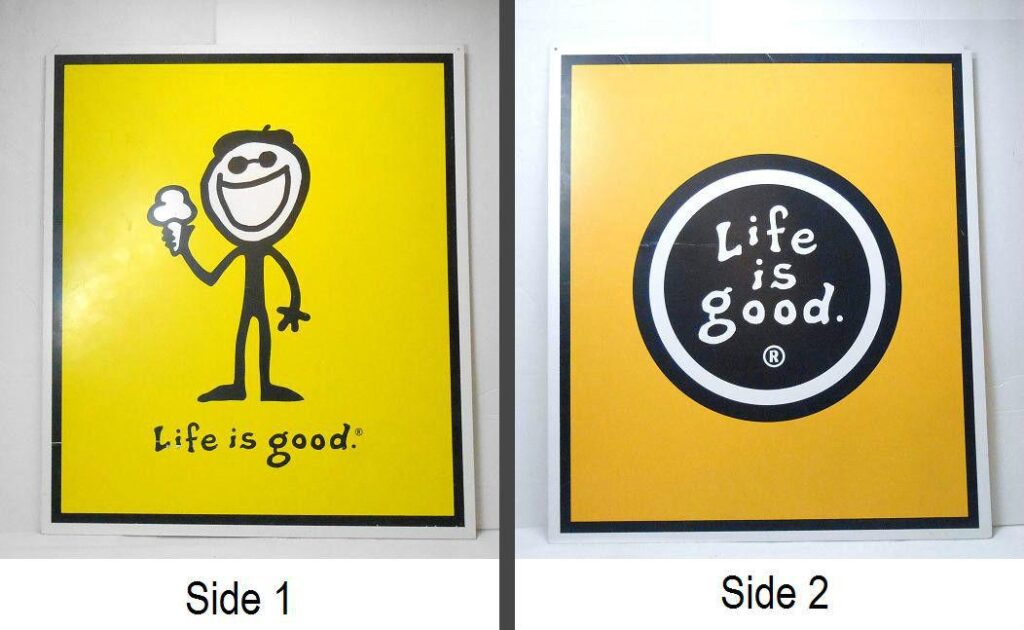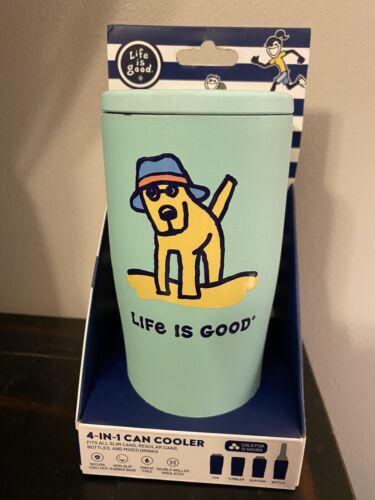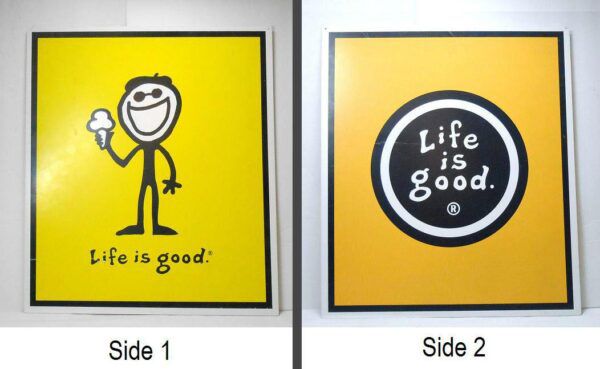#Life #Good #Selling #Positivity #WorthPoint

In 1994, three simple words saved John and Bert Jacobs’ failing apparel business: “Life is good.” After years of struggle, the Boston, Massachusetts, brothers added that cheerfully decisive slogan to their graphic T-shirts, and almost overnight, their business morphed into an entrepreneurial powerhouse.
While the company continues lending its message of positivity to T-shirts and accessories like backpacks, slippers, mugs, hats, and water bottles, its vintage and used pieces remain popular with thrifters and resellers. Why? It could be because we never outgrow our desire for a positive message.
From Rags to T-Shirt Riches
After numerous fits and starts, the Jacobs brothers learned that the message you’re selling can sometimes become more important than the item you’re selling it on. Their journey to success began in 1988, with a seven-week cross-country road trip during which they decided to embark on a T-shirt retail business. The brothers tried and failed for several years with their “Jacob’s Gallery” company, traveling to college towns along the East Coast and selling T-shirts from their Plymouth Voyager van.
As the company continued its freefall, the brothers—once with only $78 in their bank account—asked themselves, “What do we stand for?” It became the force that turned the business around, John Jacobs said in a 2016 interview with Business Insider. Tired of reading negative news in the media, they searched for an uplifting slogan and eventually landed on “Life Is Good.” John Jacobs, the artistic brother, drew “Jake,” a cartoon stick character wearing sunglasses, a beret, and a big smile, and combined it with the slogan. “We wondered if there was room to create some symbol of optimism, a hero whose power is the way he views the world,” Bert said in in 2012. He added that the beret showed “open-mindedness, the smile because he always finds a reason to be happy, and the sunglasses because we wanted it to be cool to be optimistic.”
After that, the brothers printed forty-eight T-shirts and quickly sold out at a 1994 Cambridge, Massachusetts, street fair. “The response was so immediate,” John said. “It was exactly what we had hoped for. People ‘got it’ and they bought it. No explanation was necessary.”
By 1997, the newly rebranded Life Is Good company reached $1 million in sales and hired three employees. Today, with its headquarters in Boston, this global business sells its products online and worldwide in over 4,500 retail stores.
I recall discovering the Life Is Good store for the first time in the early 1990s on a fall shopping trip to Brown County, Indiana. It was like entering a world of happiness and color, down to the shop staff. I walked out of that store with Christmas gifts for my entire family. I still feel I won Christmas that year precisely because everyone loved how the message made them feel—happy. The shirts themselves, while they were excellent quality, were secondary.
Selling Good Vibes on a Good T-Shirt
While the current news continues its daily cycle of adversity and heartbreak, the “Life Is Good” message still resonates with buyers. Although the company regularly adds new items and designs to its inventory, its vintage and used pieces sell well online and at thrift stores. Searching online marketplaces like Etsy, Mercari, and eBay revealed thousands of listings for vintage ceramic coffee mugs, T-shirts, coolers, and baseball caps. Also, some thrifted tops on sites like Poshmark run from $15 to $40, depending on condition and theme.
With the economy still in topsy-turvy mode, used and vintage pieces remain inexpensive, which is essential since holiday gift-giving is on the horizon. For example, “Life Is Good” vintage ceramic coffee mugs ran about $10 to $20 each, depending on the theme and availability.

Buying Used Stuff Is Also Positive
It’s an excellent time to thrift Life Is Good products because, now more than ever, it has become an acceptable practice to give used items as gifts. A 2023 story on Parade noted a survey on the marketplace app Mercari which revealed that 61 percent of its buyers were okay with receiving a used or thrifted gift. While only 38 percent of those aged 55 and older accepted it, 49 percent of those aged 18–34 supported the practice. It tracks since the younger generation is more concerned with an uncertain economy and the environment, especially climate change. They are also known for their savvy in scoring quality items at affordable prices.
Even GQ magazine heaps praise on the vintage T-shirt instead of the fresh-out-of-the-box pieces. “Vintage tees come with character that can’t easily be faked,” Gerald Ortiz wrote in a 2023 story. “They’re the antithesis of the pristine, vacuum-packed bulk buys you’ll find at big box stores. They’re a surefire way to pump an outfit with personality when things are feeling a bit lifeless. And, of course, they’re a lot better for the planet.”
A T-shirt group on Reddit also discussed the enduring value of “Life Is Good” vintage tees. “Life Is Good stuff is really good quality, too,” said user @mercurialpolyglot. “It’s that thick cotton you never see anymore because companies figured out people would still buy thin t-shirts.”
As I finish writing this blog post, my lavender Life Is Good “Namaste” water bottle is close by as a symbol that good still exists. It is dented and chipped, but looking at it makes me happy and reminds me that I can endure challenges if I just chill out.
“We’re competitive people who live in the real world,” Bert Jacobs said in an interview with InkandDescent.com. “We wake up and fight like anybody else. But we have a deep-seated belief that it’s powerful to be optimistic. And for us, the business is definitely a fulfillment of that philosophy.”
Between excursions to hunt for antiques and vintage décor, Lynda Houston is busy restoring her 1950s cottage in Cincinnati, Ohio. She and her partner Dave Beck operate TheRustInPeaceShop on Etsy.
WorthPoint—Discover. Value. Preserve.




